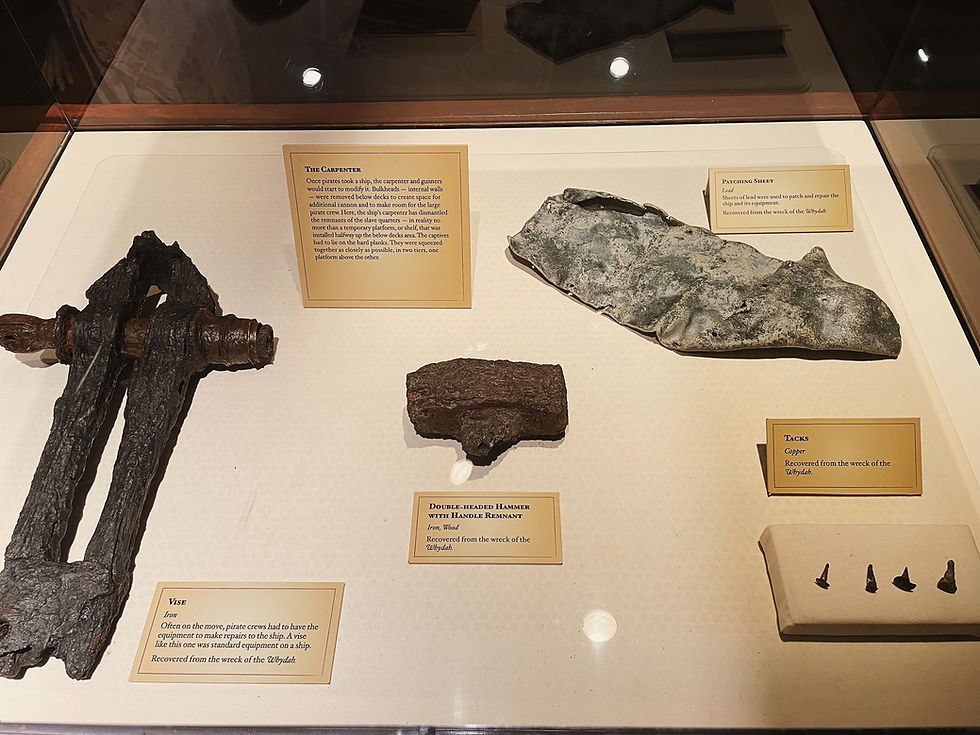Tools in Art: Albrecht Dürer
- marcsitkin
- May 7, 2020
- 4 min read
Updated: May 15, 2023

Figure 1. The Holy Family in '"Repose from the Flight into Egypt" by Albrecht Dürer, ca. 1504-05. Joseph is hewing a box with an ax, Mary is spinning with a whorl and distaff. One of the angels in the foreground is sweeping the ground with a stick, not a broom. In the background some cloth is drying on a barrel, perhaps newly fulled cloth of Mary's. Thus Dürer saw a typical carpenter in 1505.
by Anonymous, reprinted from The Chronicle, Volume XXIV, No. 4, September 1971
Appropriate for the Christmas season we thought we would take a religious theme. The way the artist has depicted factual evidence has been the despair of researchers wanting exact depiction. But in the days before cameras the artist was the only means of graphically showing what tools looked like and how they were used. Of course, the artist drew what he saw and depending on the astuteness of his vision we may have a very accurate picture of tools in use.
Albrecht Dürer (1471-1528) was a German artist who worked on all the graphic arts of the time. He was a printer. too, and must have been quite conscious of tools and their use. He was apparently an apprentice book illustrator in Nuremberg before 1490, using primarily wood-blocks. Art experts claim they can trace his type back to 1488 or before. The use of woodblocks undoubtedly made Dürer familiar with some woodworking tools. Following the conventions of the times he clothed his subjects in contemporary dress, giving us a picture of tools in the late fifteenth and early sixteenth centuries presented in a highly unusual form.
The first view (Figure 1) is taken from a life of the Virgin. It is entitled "Repose from the Flight into Egypt," and dates from about 1504-05. Joseph is at work as a carpenter. He is using a polless ax to hollow out a box of some kind, perhaps a coffin. The box sits on rather typical sawhorses. The little angels are picking up large chips of wood made by the ax but no other tools are shown. Mary is spinning, using a whorl and distaff. Judging by the way the distaff is tied she is probably spinning flax. The whorl is quite conventional but she is not holding the distaff. Unless one of the angels bothering her is holding it it must sit on a stand. As late as 1505 a typical home scene would not show a spinning wheel, which was developed not too far from Nuremberg about this time.

Figure 2. A Passion scene from 1511. Notice the extreme care which the carpenters are taking to prevent the wood of the Cross from being split.
The next views are not quite so peaceful but depict the violence of their times. The construction scene (Figure 2) is from the small Passion Book (1511) which Dürer illustrated. It shows Christ being fastened to the Cross. What is interesting about it is the extreme care the workmen are taking not to split the wood of the Cross. The man on the left is carefully drilling a hole for the spike. He is using an auger with a twist bit. The handle appears to be nicely shaped for use. The man on the right is driving the spike with a carpenter's hammer. It has a large tail but this does not appear to be a claw hammer. At the foot of the Cross is a basket for the carpenter's tools. In it are two hammers similar to the one in use, while a pincers to extract the nails lies in the foreground. It is interesting to note that the carpenter (at this time) carried his tools in a basket rather than in a sack. Even the rope necessary to raise the Cross is lying in sight. Dürer seemed to have approached the Crucifixion as a technical problem.

Figure 3. A typical auger in 1496. This is more in the nature of a ream and must have been the type used to start nailing so they would not split the wood. (Detail of Dürer's woodcut "The Martyrdom of the 10,000 Christians Under King Sapor.)
The martyrdom of the 10,000 Christians under King Sapor (1496) (Figure 3) shows a scene which appears occasionally in other of Dürer's works and in contemporary art of the period. The bishop has been killed by a rather elegant auger. The bit appears to be a simple tapered spike with a groove to carry away the chips and might be a ream.

Figure 4. Cain uses a felling ax to kill Abel. Although the ax appears unbalanced to us, it was a common type.
In the woodcut of Cain killing Abel ( Figure 4), 1511, Cain uses an ax. It is probably not a hewing ax but the type used to fell trees.

Figure 5. A peasant and smith approach the throne of fraud. used tools and costumes to identify their trade. (Detail of “The Tapestry at Michelfeld.")
The last cut (Figure 5) was copied from the Tapestry of Michelfeld which was supposed to have been about 100 years old when Dürer copied it in 1524. If this is the case the illustrations may show styles of the early fifteenth century rather than the sixteenth. A procession is approaching the throne of fraud. The peasant (left) is carrying a flail. The swingle is attached to a swivel which some people claim was not invented until later. The blacksmith or carpenter wears a leather apron and carries a hammer and a tongs or pincers. The other figures (not shown) are merchants and a knight.
These woodcuts show a very interesting use of tools not recommended for modern users. The comments here are mainly based on the work of Willi Kurth, The Complete Woodcuts of Abrecht Dürer (reprinted New York, 1946).




Comments